Monitoring Chemical Accidents in Industrial Complexes Using Tower-Installed Infrared System for Remote Chemical Detection and Long-Range Video Surveillance System
Abstract
1. Introduction
- (1)
- This system can detect and evaluate the leakage of chemical substances and the occurrence of fires or smoke through large-scale scans.
- (2)
- The system can be used for early detection of and effective responses to chemical accidents in industrial complexes.
- (3)
- The information on chemical substances detected in each section can be used to identify routine emissions of substances from workplaces.
- (4)
- Based on this, the government can manage and supervise workplaces in industrial complexes.
2. Methods
2.1. The Chemical Accident Recognition Equipment
2.1.1. Infrared System for Remote Chemical Detection (SIGIS-2)
2.1.2. Long-Range Video Surveillance System (TORUSS-LR2000)
2.2. The Facilities of the Industrial Complex Chemical Accident Monitoring System
2.3. The Industrial Complex Information
- -
- The SIGIS-2 program mode scan and chemical substance detection;
- -
- Transmission of the information about the corresponding section and substance;
- -
- The TORUSS-LR2000 automatic rotation to detected section;
- -
- Verification of monitoring software: cell number of the handling facility corresponds to the section;
- -
- Verification of workplace and substance codes of the corresponding handling facility;
- -
- Creation of a list of workplaces in which the chemical accident may have occurred;
- -
- Chemical accident alert.
2.4. The Software Solutions
3. Results
3.1. Chemicals Detected at Each Site
3.2. Match the Detection Result with the Industrial Complex Information
4. Conclusions
Author Contributions
Funding
Institutional Review Board Statement
Informed Consent Statement
Acknowledgments
Conflicts of Interest
References
- National Institute of Chemical Safety. Available online: https://icis.me.go.kr (accessed on 3 October 2022).
- Sabbah, S.; Rusch, P.; Gerhard, J.H.; Harig, R. Detection and tracking of gas clouds in an urban area by imaging infrared spectroscopy. SPIE 2013, 8743, 370–379. [Google Scholar]
- Beil, A.; Daum, R.; Harig, R.; Matz, G. Remote sensing of atmospheric pollution by passive FTIR spectrometry. SPIE 1998, 3493, 32–43. [Google Scholar]
- de Donato, P.; Barres, O.; Sausse, J.; Martin, D. Near real-time ground-to-ground infrared remote-sensing combination and inexpensive visible camera observations applied to tomographic stack emission measurements. Remote Sens. 2018, 10, 678. [Google Scholar] [CrossRef]
- Harig, R.; Matz, G. Toxic cloud imaging by infrared spectrometry: A scanning FTIR system for identification and visualization. Field Anal. Chem. Technol. 2001, 5, 75–90. [Google Scholar] [CrossRef]
- Love, S.P.; Goff, F.; Schmidt, S.C.; Counce, D.; Pettit, D.; Christenson, B.W.; Siebe, C. Passive infrared spectroscopic remote sensing of volcanic gases: Ground-based studies at White Island and Ruapehu, New Zealand, and Popocatepetl, Mexico. Geophys. Monogr. Ser. 2000, 116, 117–138. [Google Scholar]
- Chaffin Jr, C.T.; Marshall, T.L.; Chaffin, N.C. Passive FTIR remote sensing of smokestack emissions. Field Anal. Chem. Technol. 1999, 3, 111–115. [Google Scholar] [CrossRef]
- Tsao, Y.C.; Wu, C.F.; Chang, P.E.; Chen, S.Y.; Hwang, Y.H. Efficacy of using multiple open-path Fourier transform infrared (OP-FTIR) spectrometers in an odor emission episode investigation at a semiconductor manufacturing plant. Sci. Total Environ. 2011, 409, 3158–3165. [Google Scholar] [CrossRef]
- Griffith, D.W.T.; Leuning, R.; Denmead, O.T.; Jamie, I.M. Air–land exchanges of CO2, CH4 and N2O measured by FTIR spectrometry and micrometeorological techniques. Atmos. Environ. 2002, 36, 1833–1842. [Google Scholar] [CrossRef]
- Bradley, K.S.; Brooks, K.B.; Hubbard, L.K.; Popp, P.J.; Stedman, D.H. Motor vehicle fleet emissions by OP-FTIR. Environ. Sci. Technol. 2000, 34, 897–899. [Google Scholar] [CrossRef]
- de Donato, P.; Barres, O.; Sausse, J.; Taquet, N. Advances in 3-D infrared remote sensing gas monitoring. Application to an urban atmospheric environment. Remote Sens. Environ. 2016, 175, 301–309. [Google Scholar] [CrossRef]
- Garcia-Legaz, A.C.; Peral, A.C. An electro-optical surveillance system application for ship collision avoidance. IFAC Proc. Vol. 1998, 31, 263–268. [Google Scholar] [CrossRef]
- Dunkel, R.; Saddler, R.; Doerry, A.W. Use of unmanned SAR and EO/IR sensor suites for monitoring wildfires. SPIE 2017, 10188, 521–525. [Google Scholar]
- Leonard, C.L.; DeWeert, M.J.; Gradie, J.; Iokepa, J.; Stalder, C.L. Performance of an EO/IR sensor system in marine search and rescue. SPIE 2005, 5787, 122–133. [Google Scholar]
- Lee, J.H.; Jung, Y.S.; Ryoo, S.Y.; Kim, Y.J.; Park, B.U.; Kim, H.J.; Youn, S.K.; Park, K.W.; Lee, H.B. Imaging performance analysis of an EO/IR dual band airborne camera. J. Opt. Soc. Korea 2011, 15, 174–181. [Google Scholar] [CrossRef]
- Radović, J.R.; Rial, D.; Lyons, B.P.; Harman, C.; Viñas, L.; Beiras, R.; Readman, J.W.; Thomas, K.V.; Bayona, J.M. Post-incident monitoring to evaluate environmental damage from shipping incidents: Chemical and biological assessments. J. Environ. Manag. 2012, 109, 136–153. [Google Scholar] [CrossRef] [PubMed]
- Shao, P.; Shi, W.; Liu, Z.; Dong, T. Unsupervised Change Detection Using Fuzzy Topology-Based Majority Voting. Remote Sens. 2021, 13, 3171. [Google Scholar] [CrossRef]
- Fu, W.; Shao, P.; Dong, T.; Liu, Z. Novel Higher-Order Clique Conditional Random Field to Unsupervised Change Detection for Remote Sensing Images. Remote Sens. 2022, 14, 3651. [Google Scholar] [CrossRef]
- Gawlik-Kobylińska, M.; Gudzbeler, G.; Szklarski, Ł.; Kopp, N.; Koch-Eschweiler, H.; Urban, M. The EU-SENSE System for Chemical Hazards Detection, Identification, and Monitoring. Appl. Sci. 2021, 11, 10308. [Google Scholar] [CrossRef]
- Fumian, F.; Di Giovanni, D.; Martellucci, L.; Rossi, R.; Gaudio, P. Application of Miniaturized Sensors to Unmanned Aerial Systems, A New Pathway for the Survey of Polluted Areas: Preliminary Results. Atmosphere 2020, 11, 471. [Google Scholar] [CrossRef]
- Song, C.Y.; Yang, B.S. A Study on the Building of Disaster Prevention Platform for Effective Response System to Hazardous Chemical Accidents: Centering on Yeosu Industrial Complex. J. Korean Soc. Hazard Mitig. 2017, 17, 93–99. [Google Scholar]
- Harig, R.; Matz, G.; Rusch, P.; Gerhard, H.H.; Gerhard, J.H.; Schlabs, V. New scanning infrared gas imaging system (SIGIS 2) for emergency response forces. SPIE 2005, 5995, 174–181. [Google Scholar]
- Fortune Business Insights. Electro-Optical/Infrared (EO/IR) Systems Market; Fortune Business Insights: Pune, India, 2020. [Google Scholar]
- Globalsystems. Available online: http://www.globalsystem.co.kr (accessed on 3 October 2022).
- FLIR. Available online: https://www.flir.com (accessed on 3 October 2022).
- Korea Electric Power Corporation. Design Standard of Tower for Overhead Transmission Line (DS-1111); Korea Electric Power Corporation: Naju, Republic of Korea, 2013. [Google Scholar]
- He, K.; Gkioxari, G.; Dollár, P.; Girshick, R. Mask R-CNN. IEEE 2020, 42, 386–397. [Google Scholar] [CrossRef] [PubMed]
- Pinaya, W.H.L.; Vieira, S.; Garcia-Dias, R.; Mechelli, A. Autoencoders; Elsevier: Amsterdam, The Netherlands, 2019; pp. 193–208. [Google Scholar]
- Korea Ministry of Environment. Chemical Substances Control Act; Korea Ministry of Environment: Sejong, Republic of Korea, 2022.
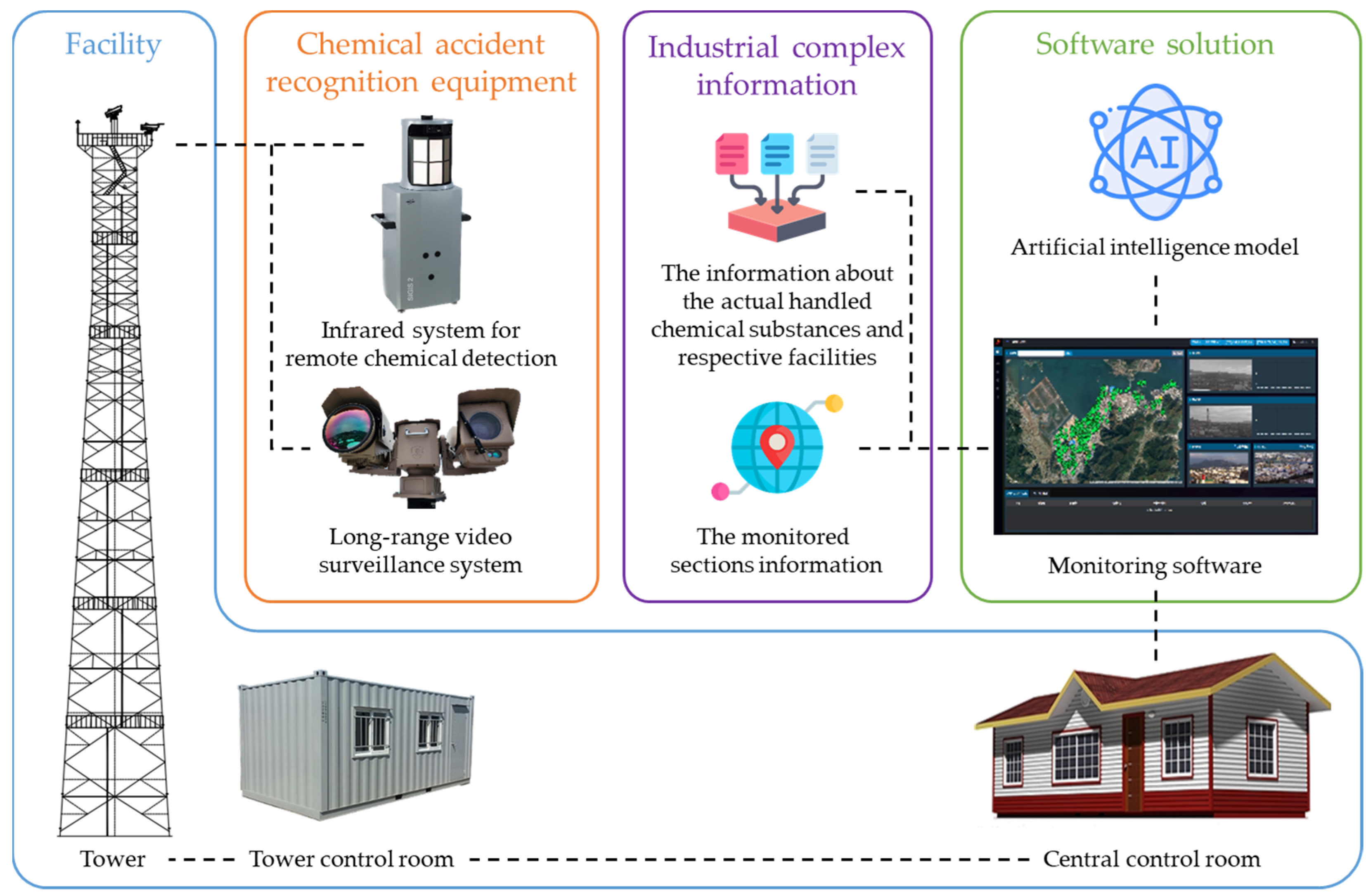



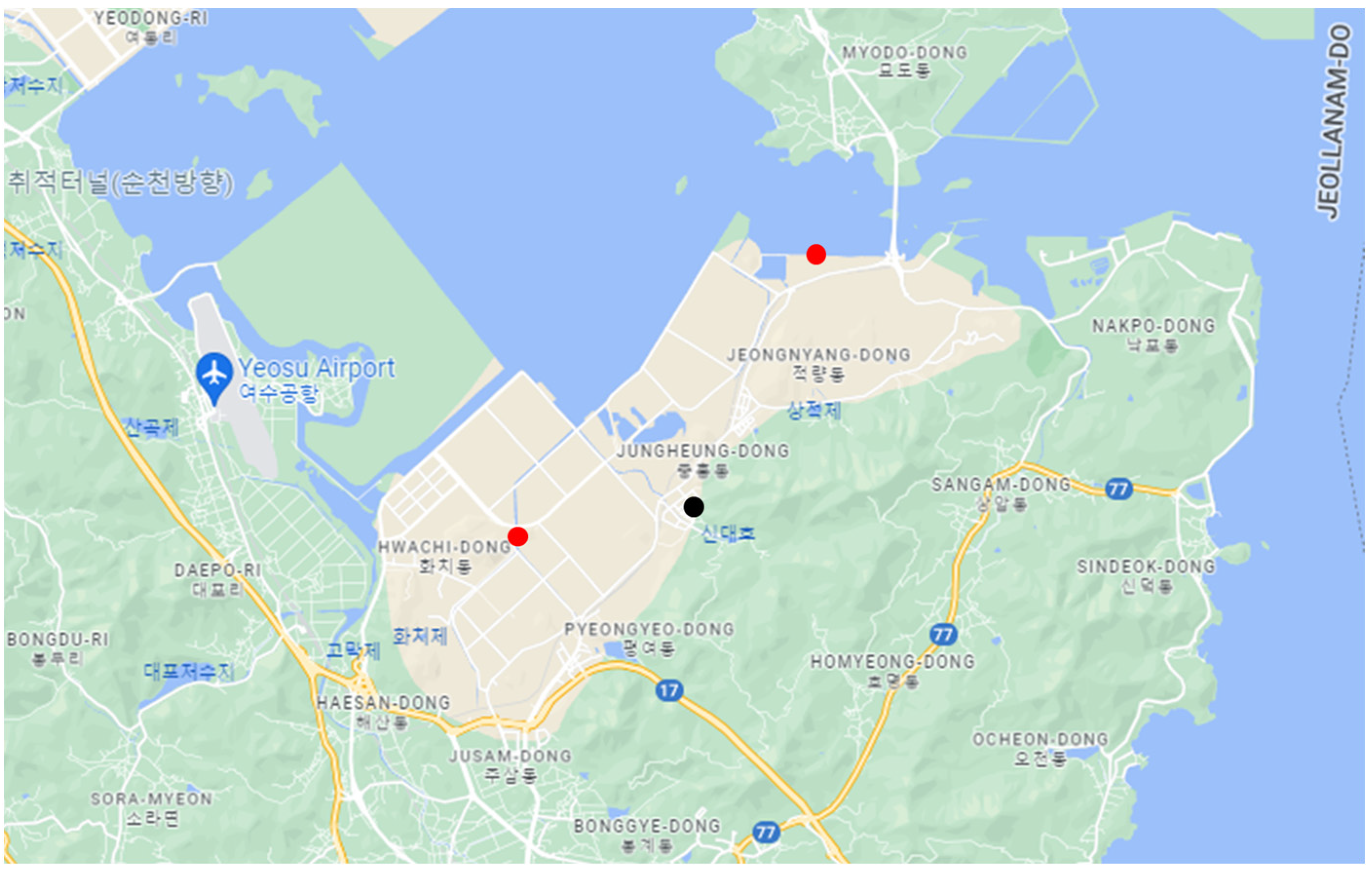
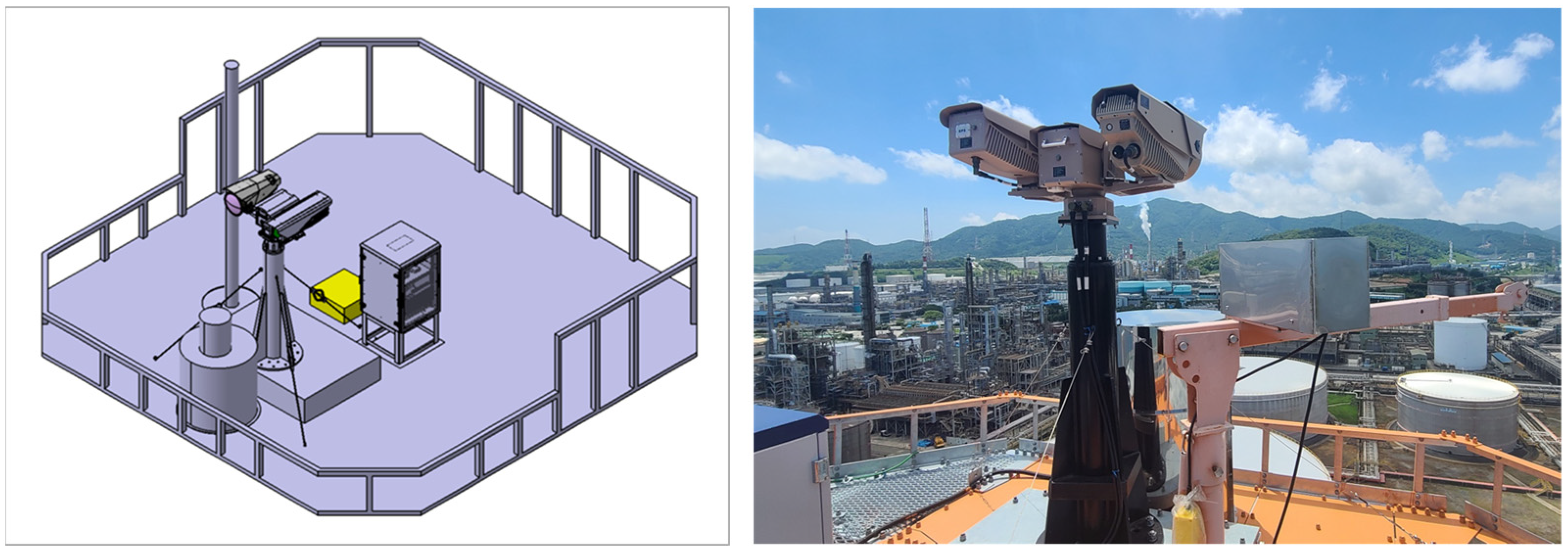
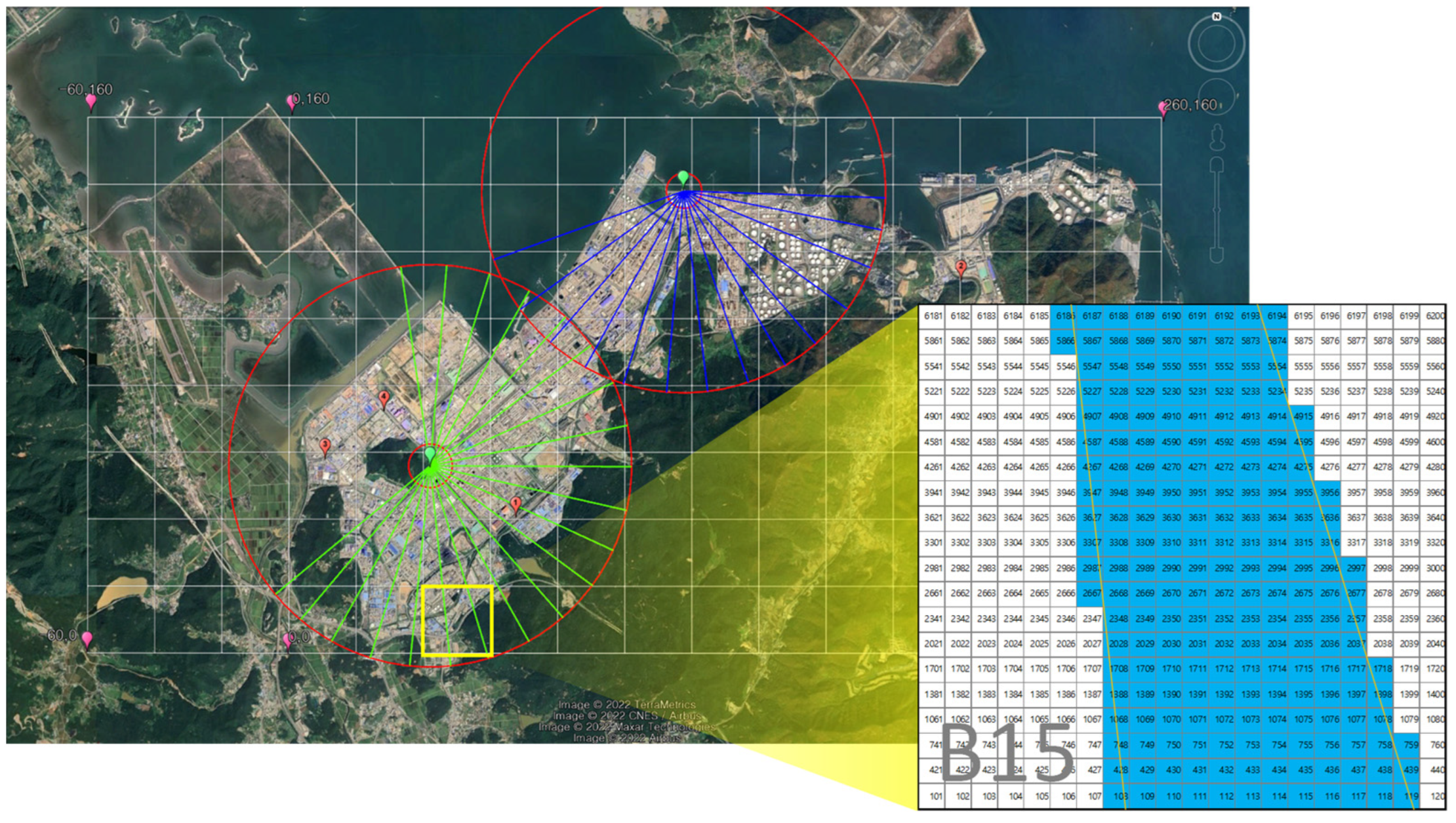




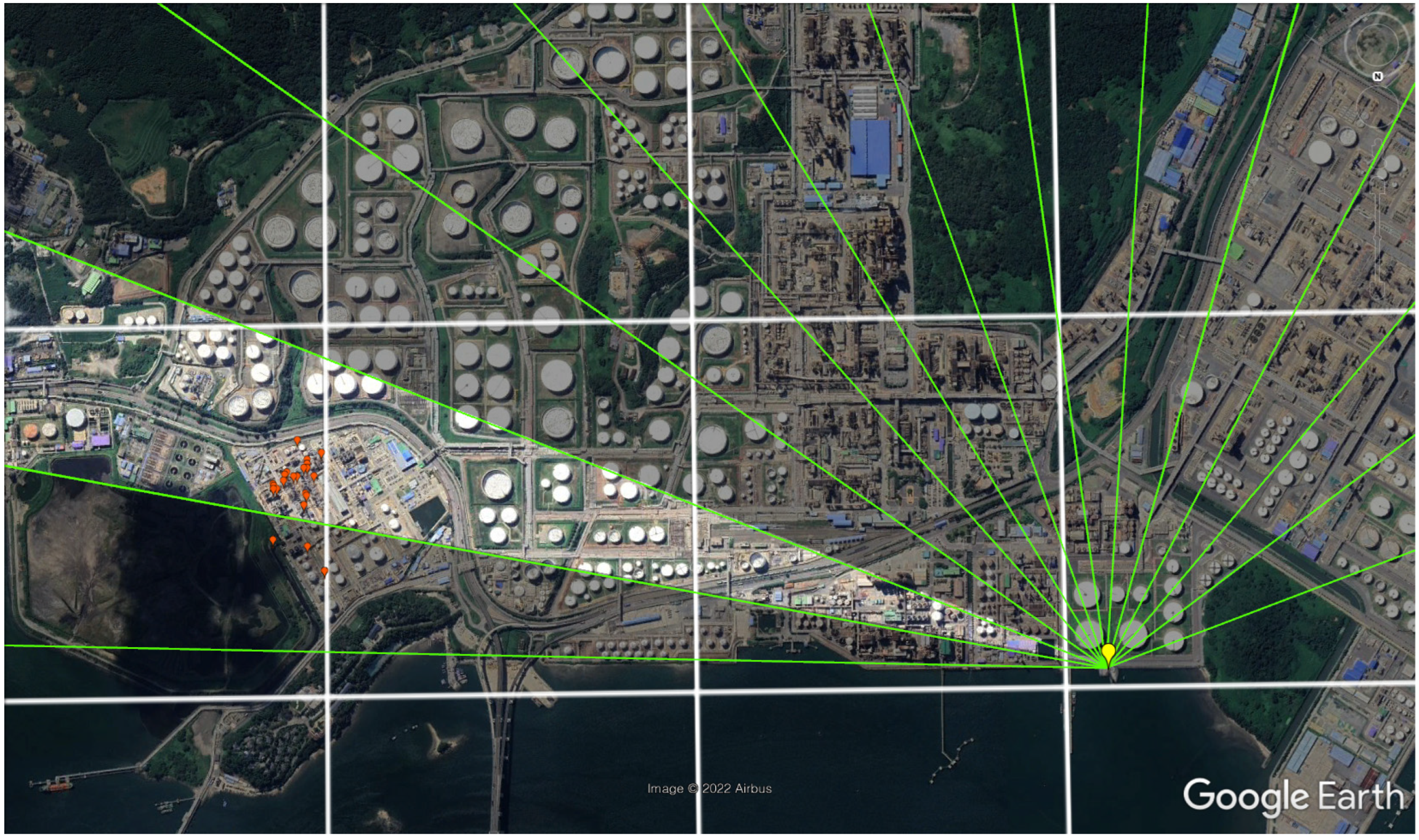
| Type | Detection | Recognition | Identification |
|---|---|---|---|
| EO camera | 19.8 km | 9.3 km | 6.0 km |
| IR camera | 18.8 km | 10.0 km | 5.5 km |
| Category | Design | |
|---|---|---|
| Safety factor, FS | 2.0 | |
| Wind load, WD 1 | Max. 60 m/s | |
| Seismic conditions, Z 2 | Zone I | 0.22 g |
| Displacement 3 | Vertical 1/1200 | Horizontal 1/800 |
Disclaimer/Publisher’s Note: The statements, opinions and data contained in all publications are solely those of the individual author(s) and contributor(s) and not of MDPI and/or the editor(s). MDPI and/or the editor(s) disclaim responsibility for any injury to people or property resulting from any ideas, methods, instructions or products referred to in the content. |
© 2023 by the authors. Licensee MDPI, Basel, Switzerland. This article is an open access article distributed under the terms and conditions of the Creative Commons Attribution (CC BY) license (https://creativecommons.org/licenses/by/4.0/).
Share and Cite
Lee, S.G.; Kim, E.H.; Ma, B.C. Monitoring Chemical Accidents in Industrial Complexes Using Tower-Installed Infrared System for Remote Chemical Detection and Long-Range Video Surveillance System. Appl. Sci. 2023, 13, 1544. https://doi.org/10.3390/app13031544
Lee SG, Kim EH, Ma BC. Monitoring Chemical Accidents in Industrial Complexes Using Tower-Installed Infrared System for Remote Chemical Detection and Long-Range Video Surveillance System. Applied Sciences. 2023; 13(3):1544. https://doi.org/10.3390/app13031544
Chicago/Turabian StyleLee, Seul Gi, Eun Hee Kim, and Byung Chol Ma. 2023. "Monitoring Chemical Accidents in Industrial Complexes Using Tower-Installed Infrared System for Remote Chemical Detection and Long-Range Video Surveillance System" Applied Sciences 13, no. 3: 1544. https://doi.org/10.3390/app13031544
APA StyleLee, S. G., Kim, E. H., & Ma, B. C. (2023). Monitoring Chemical Accidents in Industrial Complexes Using Tower-Installed Infrared System for Remote Chemical Detection and Long-Range Video Surveillance System. Applied Sciences, 13(3), 1544. https://doi.org/10.3390/app13031544






